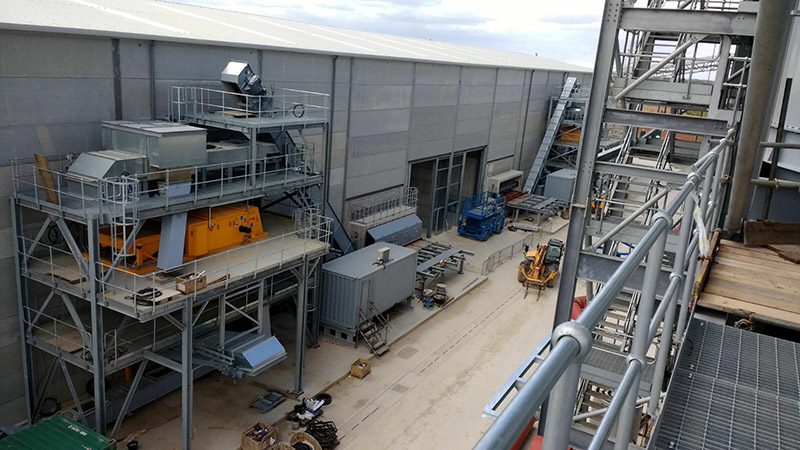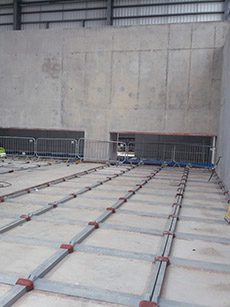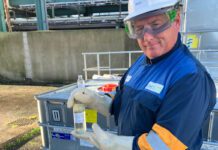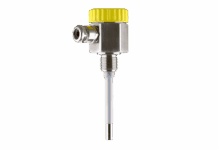Matt Drew of materials handling specialist Saxlund International describes the ingredients and challenges presented by a biofuel handling and storage system for an energy-from-waste plant
If biofuels were an animal, they would be nothing as lively as the ‘bio’ in the name might suggest. They might be a chameleon, given their multiplicity of different forms, and their ability to change characteristics completely between one week (or even one shipment) and the next. But they also share something of the sloth in their general reluctance to move.
In a nutshell, these are the principal challenges with handling and storing biomass as a feedstock for energy-from-waste (EfW) plants. Whatever their consistency, these are not free-flowing products. At the same time, what is actually meant by ‘refuse-derived fuel’ (RDF) or even ‘waste wood’ can vary considerably, and operations need to be prepared to handle the widest possible range of materials.

But in the experience of Saxlund, over many years and very many EfW and biomass energy projects, the challenges are not only to do with the material itself. One important limitation is the size of a site and the amount of land available for storage. Customers’ budget restrictions may also have a part to play. But having a range of solutions to hand, and many operational examples in the field, means we are able to work around all of these complicating factors – and others besides.
First principles
Key technologies for handling and storage revolve around the ‘first in, first out’ principle. The less time bio-based materials are left to compact and to degrade the better. Some waste shipments will fall outside quality specifications before they even arrive at the plant, but it is essential to minimise the additional cost and operational issues of allowing feedstock to become unusable while it is in on-site storage.
For most materials, some form of Sliding-Frame or Push-Floor system is advisable. These types of system make for dynamic rather than static storage and ensure that easily-compacted materials are kept on the move and not allowed to accumulate. Other options for enforcing ‘first in, first out’ include hydraulic rotors and tube feeders.
In general terms, given the nature of these materials, our system design favours vertical rather than inclined surfaces, broad rather than narrow channels and positive handling options such as screw-feeders. Far too often, we are called in to ‘fix’ biofuel storage which has been installed by supposed experts in general ‘materials handling’, but where those responsible appear to have very little experience of handling these specific types of challenging material.
Sometimes, customers can be over-optimistic in their expectations when it comes to quality consistency in feedstock. This is especially true of feedstock being shipped in from external sources. At the planning stage, we will be given a material specification; but as a company, we will always be cautious about taking that too literally.
For example, we have designed many installations for ‘waste wood’. This might sound like a fairly consistent input material, but out of nine trucks making deliveries every hour, at least one shipment may be largely or completely composed of fine dust. It may be black and compacted from having been kept for too long. In extreme cases, these consignments will be rejected. Yet there will always be material which is accepted, but which still tests the capabilities of installed systems.

Managing quality
A current project involves the handling and storage facilities for the Tansterne Advanced Biomass Project near Hull. The plant comprises two boilers, each with its own fuel line fed from a 200m3 push-floor fuel bunker. Tansterne is designed to take in approximately 250,000 tonnes of waste wood per annum. In this case, we agreed with the customer to employ crane-fed delivery into each bunker.
Where the quality and handling characteristics of input material can be made more consistent, of course, that inevitably makes for a smoother pipeline. When that material is shipped in by third-party suppliers and from different locations, it may be difficult to guarantee that consistency. But where RDF is processed on the same site, such continuity should be easier to achieve.
For example, the key parameters affecting ease-of-handling with RDF are particle size and moisture content. Reliable monitoring of the shredding stage in processing should be able to deliver the optimum particle size range. But moisture content above 35%-45% will result in RDF which is extremely difficult to handle. This is likely to depend on food waste content. Consequently, the quality of RDF handling and storage will be determined to a great extent by the quality of upstream fuel processing systems.

Many of these handling issues apply to the UK’s first bio-substitute natural gas generation plant, built at Marston Gate, Swindon, and due to become operational in early 2018. Yet again, Saxlund was entrusted with providing fuel handling and storage for the plant, with the ability to cater for both waste wood, as the principle feedstock type, and RDF.
The plant is expected to process 10,000 tonnes of RDF a year.

Tight space, tight budgets
As well as highlighting the need for flexibility and the ability to manage quite different materials in the same handling and storage system, Marston Gate shows how the imaginative use of technology can help to overcome space constraints. The site combines a docking station, which allows a single walking-floor trailer to be unloaded efficiently, with a 100m3 push-floor storage bunker, with chain conveyors to transport fuel to the gasifier.
Due to this limited on-site storage capacity, continued operation over weekends and public holidays can be assured by using metered discharge of fuel from a walking-floor trailer left at the docking station. This capability allows for a combined capacity of up to 200m3 of RDF to be fed into the gasifier as required.
Here, as on other sites, a key objective is to minimise any requirement for manual intervention, by designing automated handling which can cope with all eventualities.
In an installation at another customer’s plant, waste sorting, reprocessing and the production of RDF happen on-site. The facility requires two-to-three days of fuel to be available in storage at any one time. Since here too space is at a premium, we created an 18m x 18m x 9m bunker to house the RDF and ensure it could be discharged as required using our Push Floor technology.
Budget constraints may constitute another limitation on plant design. For example, where customers have already invested heavily in handling and storage systems which, for one reason or another, are non-functional, they may be understandably reluctant to spend similar amounts on correcting the problem. This is a situation that we witness all too often.
Sometimes, there is no easy way of working with the current installation. At one UK BioEnergy plant we have had to design a stop-gap solution, by-passing the existing fuel handling system with an inclined conveyor. At some point in the future, the customer is likely to invest in a new storage silo with a sliding frame system; but for now, the budget will not stretch that far.
Capital v operational cost
Contractors and suppliers across a range of industries like to think of themselves as strategic partners in their particular type of project. As such, they argue for involvement as early as possible in their own particular planning and design process. We, of course, maintain that this is especially important when it comes to biomass handling and storage, precisely because feedstocks can vary so widely in terms of type and quality.
At the same time, with operators understandably focused on the front-end process, it is easy for the planning team to underestimate how critically important it is to specify the best storage and handling system to meet the current and future needs of that plant. Other team members are unlikely to be aware of all the technologies – and all the options for that specific plant – which are available.
As everyone in the waste management sector knows, there is no shortage of EfW plants currently being planned and built in the UK. When it comes to operations at the construction phase, our company is implementing fuel handling and storage for around half of those projects. As a group, we have never been this busy before.
Why is that? We feel there is a learning and maturing process in play here. Some operators have tried simpler – and often cheaper – solutions, but are increasingly looking beyond the initial capital cost and (rightly) demanding more reassurance about operational costs. Most importantly, any investment model depends on plant availability.
It does not matter what capital expenditure savings you can show, if the end result is an operation which cannot hit output targets or, as may happen, does not operate at all.






